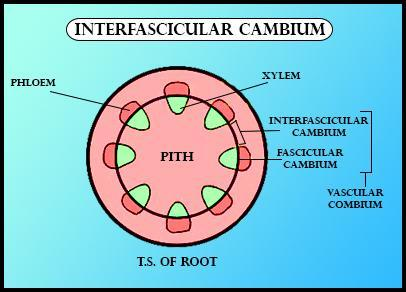Answer
395.1k+ views
Hint: They are cellular structures found in some species of wood. They seem like radial planar structures, perpendicular to the growth rings, which are visible to the eye. During a transverse section, they seem as radiating lines from the centre of the log. In an axial section, they'll appear as a spread of transverse markings.
Complete answer:
Interfascicular cambium mature from the cells of medullary rays. The cambium present between the primary xylem and first phloem is named as Intrafascicular cambium. At the time of secondary growth, cells of medullary rays, during a line with Intrafascicular cambium become meristematic and form interfascicular cambium. Therefore, the Interfascicular and Intrafascicular cambiums constitute an endless ring that divides the primary xylem and primary phloem and is understood as a cambium ring. These medullary or pith rays are important for the radial transportation of the water, minerals, and other organic substances. They transport the substances from the centre to the periphery. These rays also are referred to as vascular rays or pith rays. Xylem parenchyma is a component of complex tissue called “Xylem”. Parenchyma cells of xylem are mainly involved within the storage of carbohydrate, fats and water conduction. The Pericycle may be a cylinder of parenchyma or sclerenchyma cells that lies just inside the endodermis and is the outermost part of the stele of plants. It is involved in lateral root initiation and development also as in secondary root growth. Intrinsically it contributes to formation of the basis system and provides rise to 2 secondary meristems in roots: vascular cambium and cork cambium. The endodermis (the innermost layer of the cortex adjacent to the Pericycle) consists of closely packed cells that have within their walls Casparian strips, water-impermeable deposits of suberin that regulate water and mineral uptake by the roots.

So, the correct answer is ‘Medullary rays’.
Note: Vascular cambia are present in dicots and gymnosperms but not monocots (which usually lack secondary growth). A couple of leaf types even have a vascular cambium. In dicot and gymnosperm trees, the vascular cambium is the obvious line separating the bark and wood; they even have a cork cambium.
Complete answer:
Interfascicular cambium mature from the cells of medullary rays. The cambium present between the primary xylem and first phloem is named as Intrafascicular cambium. At the time of secondary growth, cells of medullary rays, during a line with Intrafascicular cambium become meristematic and form interfascicular cambium. Therefore, the Interfascicular and Intrafascicular cambiums constitute an endless ring that divides the primary xylem and primary phloem and is understood as a cambium ring. These medullary or pith rays are important for the radial transportation of the water, minerals, and other organic substances. They transport the substances from the centre to the periphery. These rays also are referred to as vascular rays or pith rays. Xylem parenchyma is a component of complex tissue called “Xylem”. Parenchyma cells of xylem are mainly involved within the storage of carbohydrate, fats and water conduction. The Pericycle may be a cylinder of parenchyma or sclerenchyma cells that lies just inside the endodermis and is the outermost part of the stele of plants. It is involved in lateral root initiation and development also as in secondary root growth. Intrinsically it contributes to formation of the basis system and provides rise to 2 secondary meristems in roots: vascular cambium and cork cambium. The endodermis (the innermost layer of the cortex adjacent to the Pericycle) consists of closely packed cells that have within their walls Casparian strips, water-impermeable deposits of suberin that regulate water and mineral uptake by the roots.

So, the correct answer is ‘Medullary rays’.
Note: Vascular cambia are present in dicots and gymnosperms but not monocots (which usually lack secondary growth). A couple of leaf types even have a vascular cambium. In dicot and gymnosperm trees, the vascular cambium is the obvious line separating the bark and wood; they even have a cork cambium.
Recently Updated Pages
How do you arrange NH4 + BF3 H2O C2H2 in increasing class 11 chemistry CBSE

Is H mCT and q mCT the same thing If so which is more class 11 chemistry CBSE

What are the possible quantum number for the last outermost class 11 chemistry CBSE

Is C2 paramagnetic or diamagnetic class 11 chemistry CBSE

What happens when entropy reaches maximum class 11 chemistry JEE_Main

Calculate the volume occupied by 88 gram of CO2 at class 11 chemistry CBSE

Trending doubts
Difference between Prokaryotic cell and Eukaryotic class 11 biology CBSE

Difference Between Plant Cell and Animal Cell

Fill the blanks with the suitable prepositions 1 The class 9 english CBSE

Change the following sentences into negative and interrogative class 10 english CBSE

Give 10 examples for herbs , shrubs , climbers , creepers

What organs are located on the left side of your body class 11 biology CBSE

Write an application to the principal requesting five class 10 english CBSE

What is the type of food and mode of feeding of the class 11 biology CBSE

Name 10 Living and Non living things class 9 biology CBSE



